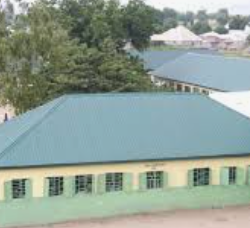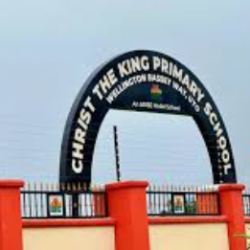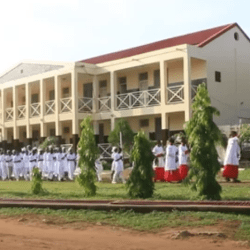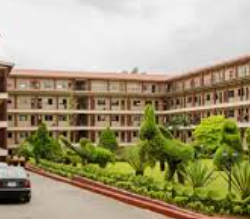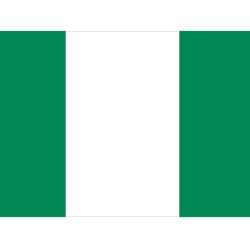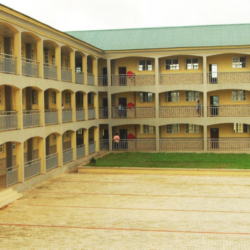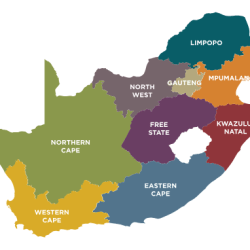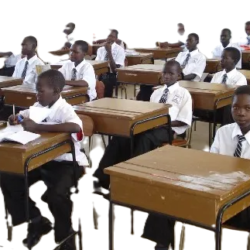Kontagora is a town on the south bank of the Kontagora River in north-west Niger State, Nigeria.

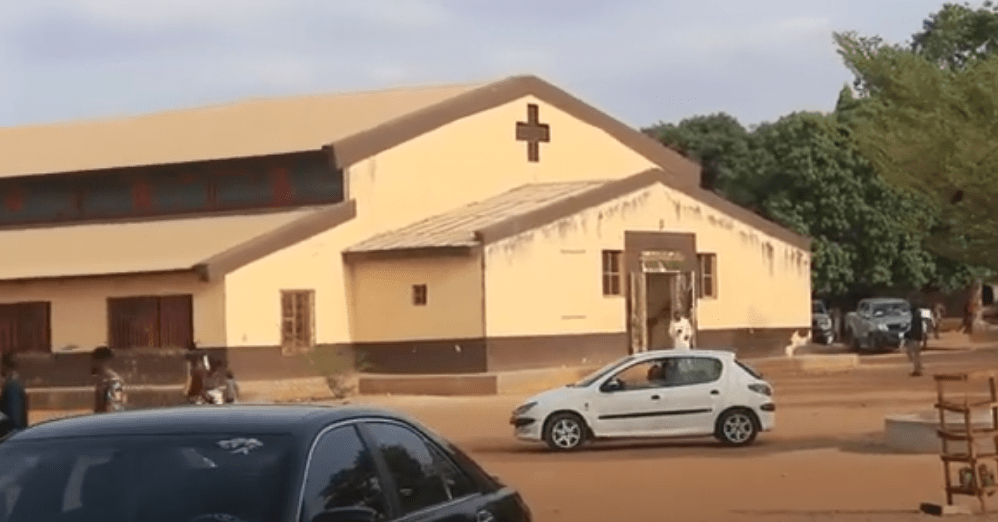

On December 15, 1995, the Roman Catholic Apostolic Vicariate of Kontagora was established here. St Michael’s Cathedral is the seat of the apostolic vicar.
Before the arrival of other tribes, the area of what was known as Kontagora Province consisted of Borgu peoples settled on the west bank of the River Niger, Yawuri and Kambari tribes in the centre, the Dakarkari, Kambari and Dukkawa in the north, Kamukawa and Kambari in the north-east, Gwarawa in the east and south-east and the Nupes in the south.

The history of Kontagora links the story of the life and times of Umaru Nagwamatse and his sons, Abubakar Modibbo and Ibrahim Nagwamatse. In the combined life time of a little over fourty years (1858-1901), Nagwamatse and his protégés opened up a previously closed forestry area. Idol worship, wars among and between communities, slave raiding and absence of law and order was the environment where peace and security was restored.

Each group seemed to have originated as an independent migration from Katsina. The period of migration and settlement could be fixed only approximately as after the Achifawa and before the Katsinawa Laka. The Borgu Kingship and Yawuri Kingdom had sway on the area extracting tributes and allegiance from Bargawa and Yawurawa respectively. However the rest of the vast land was occupied by scattered communities few of which were city states headed by chiefs and headmen.

The first Fulani presence was a small settlement of pastoral Fulanis from Katsina led by Muhammadu Sambo around 1800 within the Dukkawa and Dakkarawa enclaves. Some years later, about 1804, the second presence of Fulani was brought about by Mallam Dendo and his sons Usman Zaki, Masaba, Maliki and grandson Majigi. Mallam Dendo’s sons destroyed the Nupe Kingdom and established the Fulani dynasty at Bida in 1857.
The third Fulani presence was in the Kambarawa enclave when Majidadi a Fulani from Gwandu entered into Yawuri Kingdom early 1830s. He settled at Birnin Yawuri, the capital of Yawuri Kingdom and in conjunction with the Yawurawa he subdued the Kambarawa in the surrounding country. Yawuri was one of the “Banza Bakwai” and its population consisted of Hausa ruling and middle classes living in towns, and a mainly pagan peasantry who had not adopted the Hausa language nor were they assimilated into Hausa way of life. During the Jihad the Chief had made voluntary submission to Shehu Dan Fodio and had been confirmed in office. Yawuri had therefore become part of the Empire and after Shehu’s death had paid allegiance to Gwandu.
The greatest enterprise however was the single handed effort of Umaru Nagwamatse, the Sarkin Sudan, who laid the foundations of Fulani presence and influence in Kambarawa, Gwari, Basawa, Pangu and Kamuku areas. His work was consolidated by his two sons, Modibbo and Ibrahim which eventually led to the creation of present day Kontagora Emirate.
On December 31st 1924 Kontagora Province ceased to exist. Yelwa and Dabai Divisions were incorporated into Sokoto Province and Kontagora Division into Niger Province. Borgu had earlier gone into Ilorin Province in 1923.
Wushishi area of Nagwamatse’s territory was treated separately. Ibrahim Abubakar Modibbo was appointed Sarkin Wushishi 2nd Class in 1902 and under him were the following districts, Wushishi, Maikunkele, Bosso, Paiko, Galadima Kogo, Guni, Xan Guno, Kuta, and Fuka with headquarters at Minna. In 1923 Sarkin Wushishi was reduced to Emir 3rd Class and the Gwari Units were placed under Kuta. Wushishi became an independent district in Zungeru Division. In 1976 Wushishi became a district in Kontagora Division where it has remained since.
Gwamatsawa Dynasty in Kontagora
Beginning with the Umaru Nagwamatse the founder of the dynasty in 1859, Nagwamatse was succeeded by his protégés as follows:
- Umaru Nagwamatse
1859-1876
17 years - Abubakar Modibbo
1876-1880
4 years - Ibrahim Nagwamatse
1880-1929
49 years - Umaru Maidubu
1929-1961
31 years - Mu’azu Ibrahim
1961-1974
14 years - Sa’idu Namaska
1974 to date
35 years
UMARU NAGWAMATSE: 1806-1876. HEAD OF GWAMATSAWA DYNASTY.
Umaru Nagwamatse was the 10th son of Sultan Abubakar Atiku a grandson of Usman Danfidio, and a younger brother to Ahmadu Zaruku the 5th Sultan. He was born at Wamako in 1806. Umaru Nagwamatse was born during the early stages of Jihad which was launched by his grandfather Usman Dan Fodio. Nagwamatse was a man of action, full of character, and determination which was misunderstood and interpreted as ambition for the Sultanate.
In 1846 Nagwamatse was entrusted with the command of a post on Sabon Birni-Isa-Kaura Road at Katuru, north of Kaura Namoda. With Isa to the north and Zurmi further, this was a fortress in the upper Rima valley by means of which the Fulani were trying to contain the Gobirawa and Katsina diehards, who were then rapidly recovering their strength with their headquarters at Tsibiri. Nagwamatse was very successful at Katuru, drawing a large following and acquiring enormous wealth and popularity. His second posting was to assist Agwaragi, Sarkin Mafara. Nagwamatse was stationed at Agwara which was a Zamfara town, the most populous and important in central Sokoto. Nagwamatse’s role was not to rule it himself but to act as a Fulani Resident and keep an eye on the Sultan’s vassal, Sarkin Mafara Agwaregi whose loyalty was suspect. Nagwamatse spent two years with Agwaragi campaigning in the Zamfara territory and making things very difficult for the enemy. He grew more wealthy and popular than when he was at Katuru. Nagwamatse’s third and final assignment under the Caliphate was to the frontier post at Gwamatse in the Zamfara valley, east of Bakura and 30 miles from where Gusau now stands. Umaru was recalled from Gwamatse base because of the fear entertained in Sokoto and Wurno that if he was allowed to continue in office the whole of Zamfara would submit to him out of fear. Umaru acquired his name Nagwamatse because of his brief stay at Gwamatse.
Umaru Nagwamatse’s Departure from Sokoto
Nagwamatse spent another year without any assignment from the Sultan. He became convinced that there must be some conspiracy against him. Nagwamatse finally decided to leave Sokoto so that he would gain his freedom and eventually become more usefully engaged. On the pretext of visiting his uncle, Nagwamatse took permission from Sultan Aliyu Muhammad Bello to visit Mallam Halilu Abdullahi the Emir of Gwandu.Umaru Nagwamatse left Sokoto in 1850 without fanfare taking a wife, his companion Tukura Abdu, Mallam Dodo Zagi and three of his eldest sons.
When Nagwamatse left Sokoto and arrived at Gwandu, he narrated his bitter experience at Sokoto. He sought permission to proceed to the troubled Nupeland which was under the jurisdictional supervision of Gwandu. He wanted to go there in order to mediate and possibly try his fortune.
Umaru Nagwamatse with the Dendos in Nupeland.
Nagwamatse arrived in Nupeland to find that the emerging Fulani Emirate an affiliate of Gwandu arm of the Caliphate was in a troubled state. Nagwamatse tried to mediate between Masaba and Umaru Bahaushe without success. Failing to reconcile the two war commanders, Nagwamatse moved south.
It happened that Makama Dogo, who later became first Emir of Nassarawa but who was then still only a soldier of fortune employed by the Emir of Zazzau, was at that time conducting his campaign in the Lower Benue valley against the Igbirra Kingdom of Panda. For a time, Nagwamatse served with him and helped him to take the important town of Toto from Abuja (Habe). Nagwamatse was in the area for about two years. He used Keffi and Tashibo as staging posts.
In Nupeland, Majigi’s victory led to the return of Usman Zaki and Masaba from Gwandu and Ilorin respectively. Majigi declined to be installed the new Etsu Nupe, and instead Usman Zaki was confirmed Etsu Nupe by Gwandu while Masaba was appointed as the Shaba (heir apparent). Other members of the family took titles such as Makun, Kpotu and Nakorji. The Family endorsed Bida which was a small village founded by the Benis as the new Headquarters of the Emirate. These arrangements were confirmed by Gwandu in 1857.
With these new developments, Nagwamatse returned to celebrate with the Dendos and to establish a truce between Umar Bahaushe’s fighters and the new Nupe rulers. Subsequently Nagwamatse remained with the Dendos at Bida. Under the directive of Usman Zaki, Nagwamatse accompanied Masaba on an expedition to Minna in Gwari country. On hearing of Usman Zaki’s death, Masaba abandoned the expedition and returned to Bida. However, Nagwamatse decided not to return with Masaba, but to proceed and find his own fortune.
Etsu Masaba who has just succeeded Usman Zaki, allowed Nagwamatse to establish his camp at Bogi (Wushishi), and operate in a no-man’s-land to the north-east which lay between Yauri, Sokoto, Zaria and Nupe.
Nagwamatse’s Departure from Nupeland
The territory into which Nagwamatse now moved was outside the borders of Hausa land and had never been effectively controlled or occupied by the Fulani. The territory was very extensive, at least ten thousand square miles, and inhabited in the north by numerous tribes and communities of a few city states.
Nagwamatse established his camp at Bogi a short distance from the town of Wushishi on the Niger River. Gradually the camp and the village merged. It was a good site and within reach of Gwarawa villages and towns. The growing strength and popularity of Nagwamatse’s camp at Bogi became widely known in Nupe and surrounding areas. For this reason, fighters from Umar Bahaushe, Masaba’s erstwhile commander, sought permission from Masaba, the Etsu Nupe, to join Nagwamatse at Bogi. Within three years, Nagwamatse’s camp was bustling with worriers of all types and from most parts of the present day northern states.
Installation as the Sarkin Sudan (1859)
Nagwamatse’s conquests became more and more considerable to the extent that when his elder brother Ahmadu Atiku (Zaruku) succeeded Aliyu Mohammad Bello (Aliyu Baba) in 1859 as the 5th Emir of Sokoto, he lifted the ban on his brother imposed by Sultan Aliyu Babba and conferred the title of Sarkin Sudan King of the Blacks on him. Sultan Ahmadu Atiku’s message was brought to Nagwamatse by Dikko Uban Dikko Haliru at Shata. Nagwamatse was at that time about fifty three years old. The brief ceremony was performed and the ceremonial robe (alkyabba) two horses and Kadiriyya Flag were presented to him by the Sultan’s representative. Nagwamtse’s installation further established the tradition where the title of Sarkin Sudan was given directly by the Sultans of Sokoto to the descendents of Umaru Nagwamatse, until British colonial administration was established in the Emirate. His first son Abubakar Modibbo was conferred the title of Dangaladima.
Consolidation of Territories
For the next three years Umaru Nagwamatse engaged the chiefs of Gwarawa city states and established his presence and gained acceptance in the areas which he operated. He established three patrol posts, one at Bogi (Wushishi) and the others at Shata and Yelwa. His first son Abubakar Modibbo was assigned to hold all of them at one time or another.
With peace established in Gwarawa territories, he proceeded northwards to Kotonkoro, Kakihum and Kumbashi whose population consisted of Kamukawa, Katsinan Laka and Kambarawa. Nagwamatse confronted and defeated a combined force of Kotonkoro, Maradi, Sarkin Gwari and Anka.He took Kuyanbana and the Kambarawa of Rijau. Umaru Nagwamatse moved west and founded the town of Kontagora in 1864. Nagwamatse died at Anaba in 1876 at the age of 70 years He was buried at Mamba.
At Nagwamatse’s death the parameters of Kontagora Emirate was already established. The area consisted of an expanse of land that stretched from Anaba west of Kontagora town, Birnin Gwari in the east, Kotonkoro, Kakihum and Kumbashi to the north, Zuru, Shambo to the north-west, Minna, Gurmana Gurara to the south east and Nupe to the south.
ABUBUKAR MODIBBO 2nd SARKIN SUDAN 1836-1880
Abubakar Modibbo was born in Sokoto around 1836. He was the first son of Umaru Nagwamatse. Modibbo was one of the three eldest sons who accompanied Nagwamatse from Sokoto to Gwandu and finally to Nupeland.
Modibbo was conferred the title of Dangaladima by Sarkin Musulmi Ahmadu Atiku in 1859 when his father was made the Sarkin Sudan. Due to ill health, Modibbo did not feature much in the several battles which his father waged, before and after his installation as the Sarkin Sudan. He was however assigned to hold, at one time or another, the two most important patrol stations at Shata and Bogi (Wushishi)
Umaru Nagwamatse’s death raised the problem of succession. All his associates came freely to join him with different motives. Many came to make fortune, others to prove their outstanding skills as worriers and some came to a courageous adventurer whom they admired. Umaru Nagwamatse was the leader among equals. They all shared in the fortunes and misfortunes of the team. It was therefore legitimate for any worrier to stake a claim to the leadership of the group.
There were however two problems. The first was that the title of Sarkin Sudan which can only be claimed by a member of Abubakar Atiku’s royal family. The second problem was Madawaki Isa’s admonition when he told his comrades that a bird nests only for its young. Thus the issue of succession was closed and the stool of Sarkin Sudan was preserved as one ruling house for which eligible male members of Umaru Nagwamatse’s family may compete for appointment.
The titled men and Umaru Nagwamatse’s fighting associates therefore agreed that Abubakar Modibbo Nagwamatse’s first son should succeed his father as the 2nd Sarkin Sudan and the decision was conveyed to Sarkin Musulmi Mu’azu Dan Bello who sent the usual regalia to Modibbo at Anaba (1876). Modibbo appointed his brother Isa as the new Dangaladima. Modibbo was about 40 years old when he came to the throne as the Sarkin Sudan. At the time of his installation, Modibbo was at the patrol station of Wushishi keeping watch over the Gwari. He was invited to Kambuwa for his installation as the 2nd Sarkin Sudan.
It was Modibbo who began the expansion of Gwamatsawa influence into Kambarawa territories to the west of Sansanin Kontagora. Immediately after the installation Anaba was attacked and captured. He returned to Sansanin Kontagora taking along the way all the rebellious elements in the Kambarawa town of Ibeto. Not long after his arrival at Kontagora, he dispatched an expedition under Madawaki Isa, assisted by Dangaladima Isa to Igade. After a few days of fighting, the town was captured.
Modibbo now turned his full attention to Kambarawa territories mostly fiefs to Yawuri. Setting up an operational base at Salka a large area of the territory was brought under the control of Gwamatsawa.
Modibbo was on the throne for only four years and a few months. He died in 1880 he was survived by one child, Ibrahim who was in charge of Wushishi. Modibbo’s descendents have continued to rule Wushishi with the title of Sarkin Wushishi to date.
The present Sarkin Wushishi, Alhaji Ibrahim Abubakar is a great grandson of Umaru Nagwamatse. As descendants of Abubakar Modibbo, the 2nd Sarkin Sudan, the family is similarly eligible and free to contest for the post of Sarkin Sudan whenever there is vacancy.
IBRAHIM NAGWAMATSE 3rd SARKIN SUDAN 1859-1929.
Ibrahim Nagwamatse was born at Tashibo (Lapai) in 1859 when Umaru Nagwamatse was with Mallam Dogo. He was using Keffi and Toshibo as staging camps. Muhammadu Buayi was born at Keffi in 1854 and Ibrahim at Toshibo in 1859.
Ibrahim was very active in many fighting engagements in his father’s company. When Dangalima Isa died at Kumbashi, Modibbo appointed him as the new Dangaladima. Ibrahim concluded the campaign at Kumbashi with Ubandoma Aliyu. After the defeat of Kumbashi, Ibrahim joined Madawaki Isa for the extensive incursions into Kambarawa territories.
After the death of Abubakar Modibbo in 1880, Ibrahim was appointed the 3rd Sarkin Sudan at Libele by a council of six notables that included Madawaki Isa, Mallam Habibu, Galadima Goyon Kura, Ubandoma Aliyu, Aliyu Dunkule, and Tukura Abdu Dan Magaji. Ibrahim was only 23 years old. Sarkin Sudan Ibrahim appointed his brother Dodon Gwari as the new Dangaladima.
From 1880 to 1901 when the British army arrived in the Emirate, Ibrahim consolidated the territories captured by his father, and extended Gwamatsawa influence into Kambarawa territory, an effort began by his brother Abubakar Modibbo. On his own initiative Ibrahim eliminated the city states in Dakkarawa, Kwarro and Nupe areas of Zugurma.
Refusing to accept the conditions presented to him by the colonial army Kontagora town was attacked in 1901. Ibrahim and his associates escaped and marched eastwards. He was eventually arrested in 1902 and taken to Lokoja. In 1903 he was released from custody and designated as Sarkin Kontagora, however three years later in 1906, Ibrahim was formally appointed Sarkin Sudan by Lord Lugard as a 1st Class Emir with Kontagora as the headquarters of the new Emirate. Ibrahim joined hands with the Colonial administrators to set up the necessary instrument of governance in the Emirate.
Working with the British, Sarkin Sudan Ibrahim participated fully in establishing the administrative structures for the new Emirate. After his reinstatement as the Sarkin Sudan and appointment as a First Class Emir in 1906, six districts were constituted to form the new Kontagora Emirate – Mashegu, Zugurma, Ibeto, Kumbashi, Rijau and Kotonkoro. Dakarkari territory was placed under a caretaker and all the Gwarawa, Kamukawa and Pangu territories were left under the administrative supervision of Sarkin Wushishi as an independent district.
Two significant changes were made during the reign of Sarkin Sudan Ibrahim. In 1918 the Yawuri portion of the Dukawa tribe was brought into Rijau District so that all Dukawa might be under the control of one District. On 31st December 1924 Kontagora Province ceased to exist. Yelwa and Dabai Divisions were incorporated into Sokoto Province and Kontagora Division into Niger Province. Borgu had earlier gone to Ilorin province in 1923.
Lord Lugard was so impressed with the sudden and total transformation of Ibrahim that in July 1929 he awarded him the order of the CBE at an impressive ceremony in Zungeru witnessed by all the Emirs and Chiefs of Niger Province. Sarkin Sudan Ibrahim died soon after the award in October 1929 at the age of 70 years. He reigned for 49 years.
UMARU MAIDUBU 4th SARKIN SUDAN (1929-1961)
Umaru Maidubu was born in 1884 four years after his father, Ibrahim Nagwamatse became the 3rd Sarkin Sudan in succession to his brother Abubakar Modibbo. Umaru Maidubu was the first son of Ibrahim Nagwamatse and a great grandson of Shehu Usman Danfodio.
When Maidubu was eighteen years old he and 29 other children went for a swim in the Kontagora River. The competition was simple and required each child to swim across the river one after another. Maidubu was the last child to swim across. Immediately after he plunged into the waters, a crocodile appeared and swam in his pursuit. There was terror and pandemonium among his friends across the river who watched helplessly unable to do anything to save him. Fortunately he arrived at the bank of the river shortly before the crocodile could reach him.
Maidubu effectively participated in the campaigns planned and executed by his father. As a mounted worrier he accompanied his father to three battles at Chafe, Ribah and Daja. As a young prince Maidubu was at the battle with the colonial army when they attacked Kontagora town in 1901. Maidubu was with Sarkin Sudan Ibrahim and his associates when he left Kontagora through the town and moved south before finally turning eastwards on Beri road. They were tracked to Maska in Katsina Province by the Colonial army. Sarkin Sudan, Sarkin Wushishi Ibrahim, Mallam Hassan a worrier, and Dangaladima Buayi were arrested and locked up. Maidubu went to them in captivity and requested to replace his uncle Dangaladima Buaye so that he would remain with his father. The request was granted and Maidubu was locked up for three days with the other captives. Sarkin Sudan Ibrahim and Sarkin Wushishi Ibrahim were taken away to Zaria and later to Lokoja under armed escort led by Maijimina, the British Officer in charge of the operation. Maidubu, Mallam Hassan and other captives on the other hand were led back to Kontagora.
Umaru Maidubu attended the first Durbar held at Kano by the Northern Chiefs. He also attended the second Durbar also held at Kano in 1925 during the visit of Prince of Wales to Nigeria. Maidubu and his uncle Muhammadu Bello represented the Emir at a Chiefs’ Meeting held at Zaria.
Maidubu actively coordinated community efforts in the construction of roads, bridges and culverts. He served as Dangaladima, Assistant District Head (Wakili) at Kotonkoro, District Head at Mashegu (5 years), and District Head Rijau (9 years). On January 9th 1930, Umaru Maidubu was appointed the Emir of Kontagora and the 4th Sarkin Sudan. In May1931, the Lieutenant-Governor formally installed him as the Emir of Kontagora.
Umaru Maidubu inherited a system which the colonial administration established in order to govern Northern Emirates through indirect rule. A Native Authority was set up with a council in which the Emir was Chairman. The Council was not only to rule the Emirate but to collect tax, provide security and generally ensure the overall development of its area. Umaru was regarded by the British as a humane and principled emir. Maidubu understood these arrangements and quickly turned them to his advantage.
At the socio-economic level, it was during his reign that important crops like cotton and groundnuts came to be produced in large quantities for export. Kontagora ginnery built in 1938 became one of the largest in the land. Cotton Malams were trained in grading cotton with three cotton markets established (1936). Twenty nine (29) tons of cotton was bought that year by the British Cotton Growing Association. The following year (1937) one hundred and twenty tons (120) were bought by the BCGA.
Umaru Maidubu was one of the first people in Kontagora Emirate to buy a plough and a yoke of oxen, thus giving the area a good start in mixed farming. Figures however show that his enthusiasm received very little support from the people of Kontagora. Kontagora Land Settlement Scheme one of the several experiments in resettlement made after the Second World War started very well at Tungan Wawa a few kilometers from Kontagora town but was forced to wind up in 1956.
In the next two decades Umaru Maidubu succeeded in wielding his council together into what was officially acclaimed as “an admirable example of teamwork between age and youth, both working together and combining sage experience and drive for the benefit of the community. The Emir’s council was enlarged in 1955 to include the first representative of the Kambari
Three years later a joint committee was set up with Wushishi to look after financial and police affairs.
Trunk roads and agricultural feeder roads were constructed mostly by direct labour. Mariga-Kontagora, Kontagora-Yelwa and Yelwa-Rijau-Zuru were already completed by 1933. Bridges were constructed, and the bridge at Mariga was opened in 1931 while the one over the Malando River on Kontagora-Yelwa road was built in 1935.[4]
During Umaru Maidubu’s reign, Kontagora Emirate regained its historical position as one of the most powerful and prestigious emirates of the North and its leaders participated fully in the various attempts to push the emirates of Northern Nigeria into the 20th century.
Western type schools began to appear not only in Kontagora town but in the district headquarters of the larger tribes. Insisting in making education available to boys and girls Maidubu made a start with Female education when in 1935 three (3) girls entered the Elementary School Kontagora, and by 1937 there were 20 girls in the Elementary School.
The Fulanis, the Hausas and the indigenous tribes lived peacefully with one another and Islam maintained its predominance in the entire emirate[5]. The administration of the emirate was strengthened by the appointment of District heads. In 1933 Wushishi district formally an independent district was included in Kontagora Division. New District heads were appointed, Ibelu (1935); Rijau, Mallam Mu’azu Ibrahim (1937) and Kumbashi, Mallam Muhammadu Bello (1937). Within one year of these appointments, it was reported that Kumbashi showed a marked improvement since the appointment of the new District Head and the appointment of the new District Head in Rijau District has been an unqualified success.
Umaru Maidubu enjoyed travelling. In 1935 accompanied by Galadima Muhammadu who was later appointed Madawaki and Mu’azu Marafa who was then the District Head of Rijau, Maidubu visited Lagos. Mr. Dulburge, the District Officer i\c Kontagora led the group. On his way to Lagos, he visited the Emirs of Bida and Ilorin as well as the Chiefs of Oyo, Ibadan and Abeokuta. In 1938 and for the first time in his life Maidubu visited Sokoto the home of his forebears. In July 1945 Maidubu was selected along with the Etsu Nupe to participate at the Western Chiefs’ Conference at Ibadan.
Umaru Maidubu was a Member of the House of Chiefs since 1947. He was also a member of the Nigerian Ex-Servicemen Welfare Association Northern Regional Council.
Maidubu was honoured with the Silver Jubilee Medal (OBE) in 1935. His Honour the acting Chief Commissioner Mr. Morgan visited Kontagora on 22nd November 1936, and on the 24th November, he presented the Emir with the King’s Medal for Native Chiefs (CBE).
Umaru Maidubu died in 1961, and on his death he was succeeded by his younger brother Mu’azu Ibrahim Sarkin Bauchi. Maidubu ruled for thirty one (31) years.
